What is ChatGPT and what can you do with it in Jira?
ChatGPT is an artificial intelligence chat system that is surprising us all. The acronym ‘GPT’ stands for ‘Generative Pre-trained Transformer’.
It is one of the most powerful AI systems, capable of responding to ‘almost’ anything you ask it to do, and help you perform many of the requests you ask it to do.
It is an artificial intelligence that is trained to have conversations, so you only have to ask it questions in a conventional way and it will understand them.
So let’s start at the beginning, asking ChatGPT questions to find out who it is and who created it:


Now that we know who or what we are talking to, let’s see to what extent they can lend us a hand within the Atlassian ecosystem, with tasks related to Jira or to some of the most used applications.

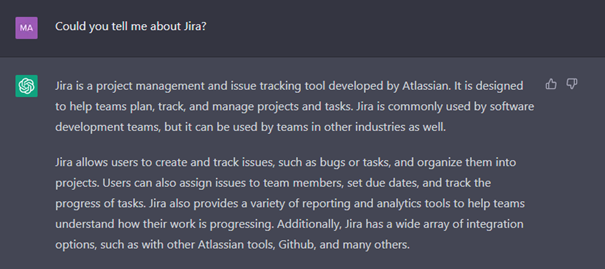
Now that we see that he knows the theory, let’s see if he is also capable of giving us solutions in practice:
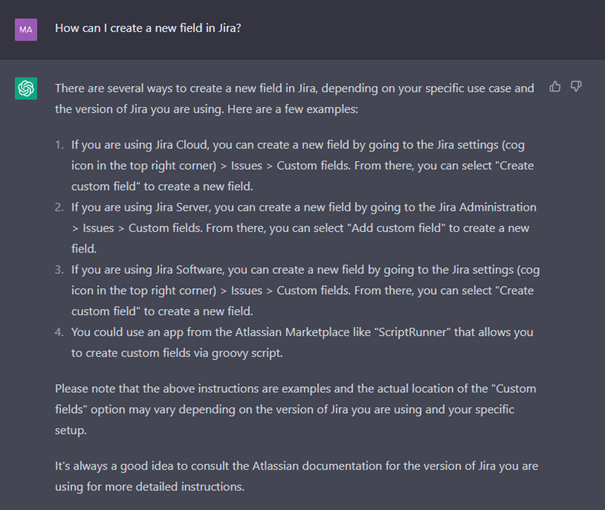
But how deep is it able to go?
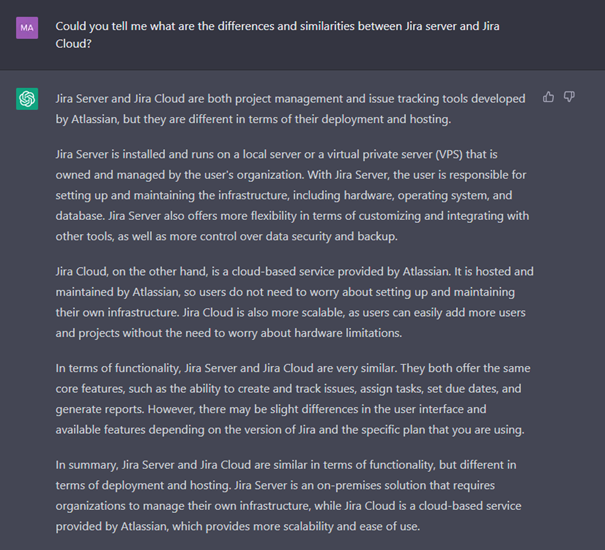
Let’s see if in addition to the products, you also know the Marketplace applications and can make recommendations:
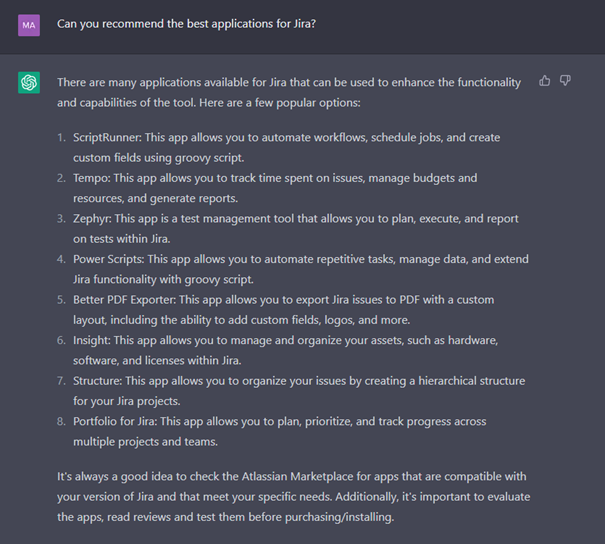
We also went deeper with another application such as Scriptrunner, to see to what extent it helps us to choose it or use it in our instances:
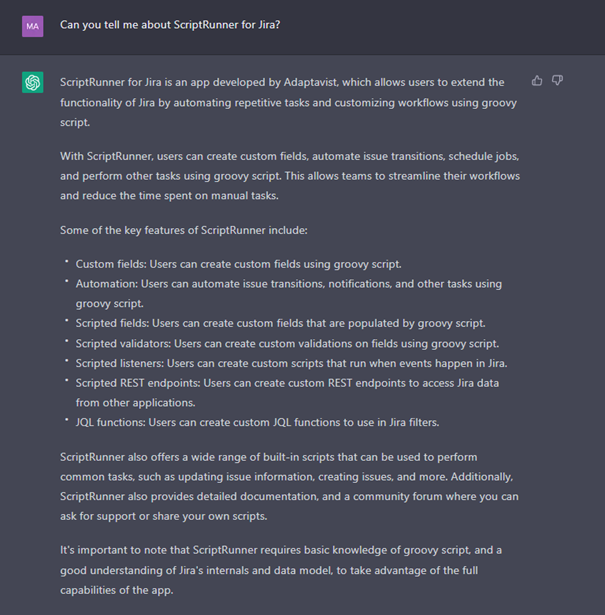
Given that, up to this point, he has been able to answer all the questions quite solidly, let’s see if he can also keep up with the more technical issues:
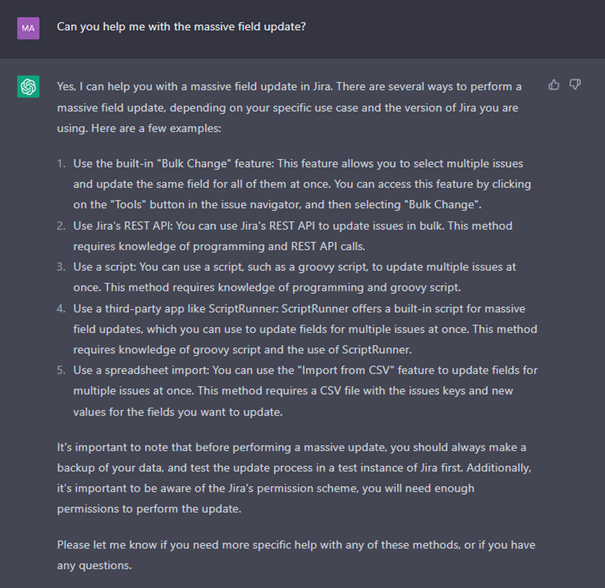
In this line we have been including levels of complexity to which it has also been able to respond without problem.
But this does not stop here, can you help us with the integration of other tools external to the Atlassian suite?
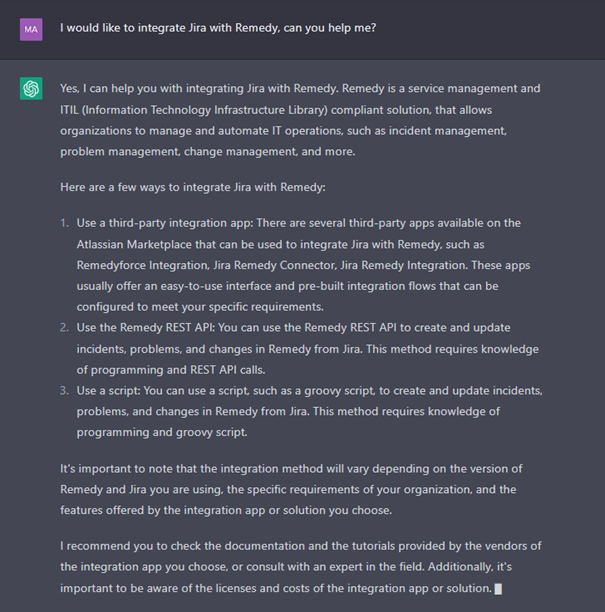
So far we have seen that not only on a theoretical level, but also on a practical level it is able to help us with almost any problem we encounter. It also offers solid answers and clarifications with a high level of depth.
In addition, we have had a long conversation with ChatGPT to explore all its functionalities and limitations. Be careful, because the knowledge base that ChatGPT uses to give its answers is up to date until 2021. If we ask it something current, it won’t know how to answer us, as it doesn’t learn new concepts.
ChatGPT’s strengths after testing:
- Produces high quality writing, this can help produce more intelligent and elaborate content.
- Supports more complex instructions, so it can perform more advanced “reasoning” tasks.
- Can generate content with high context (length).
- It can scale many tasks.
- Can solve algorithms.
- Can provide high-level and low-level help.
- Can provide scripting solutions based on real needs.
- Can help debug script errors.
Weaknesses of ChatGPT:
- Lack of information about the dataset it is trained with to understand the ‘Biases’ it may have.
- Can generate insecure code with SQL-Injections.
- Tends to write plausible but not 100% correct content with a lot of security.
- Can only be used via OpenAI endpoint so you are a “slave” to the product.
- Its knowledge base is disconnected from the internet since 2021 so it is out of date.
- It does not generate images.
In case ChatGPT gives you a wrong answer or an answer that does not meet your expectations, it is important to tell him that the example he gave you is not valid and why, and even vote his answer as negative so that next time he does not answer in that way.
Conclusion:
This analysis allows us to identify where they are failing so that we can improve them in future iterations. At the rate at which we are seeing these developments, there is no doubt that we have a very promising future ahead of us, but also one that will require a lot of responsibility from all those involved in the field.
If you want to try the chat yourself, you can do it without any problem, you don’t need to install anything.
To do so, just visit this website.
And then click on the ‘TRY CHATGPT’ button, it will ask you to register and once registered you can use it without any problem!
It should be noted that lately the chat is having a lot of impact so sometimes it makes you wait a little to use it.
Juan Martin Bortolazzo January 24th, 2023